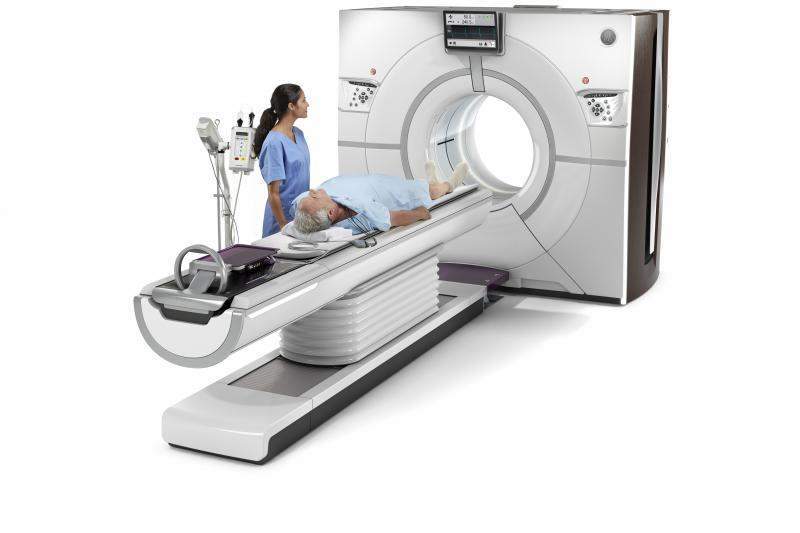A new study published in the European Heart Journal shows that GE’s Revolution computed tomography (CT) can be useful in aiding heart team in taking decision on complex coronary disease.

Image: GE’s Revolution CT. Photo: Courtesy of General Electric.
Results also suggest the state-of-the-art imaging technology may offer a non-invasive diagnostic alternative to conventional coronary angiography. Coronary artery disease (CAD) and its complications are a leading cause of death throughout the world.
According to therapeutic guidelines, left main or three vessel diseases represent the most severe, high risk CAD cases, often requiring coronary bypass graft surgery (CABG) or percutaneous coronary intervention (PCI) as treatment.
The international, multicentre SYNTAX III Revolution trial – conducted by Cardialysis on behalf of the European Cardiovascular Research Institute (ECRI) – included 223 subjects with diagnosed left main or three vessel disease. Each patient was diagnosed using conventional, invasive angiography and subsequently received a multislice CT scan on the GE Healthcare Revolution CT.
Data from each subject was evaluated by two randomized heart teams – each made up of an interventional cardiologist, cardiac surgeon, and radiologist – to make a treatment recommendation of CABG, PCI, or either. One heart team made treatment recommendations based only on the coronary CT angiography (CTA) imaging, and the other made treatment recommendations using angiography. Based on the trial’s findings, the treatment decisions between the two randomized heart teams were in almost perfect agreement (Cohen’s kappa of 0.82). These results highlight the potential of CT to not only diagnose coronary disease, but also assist in subsequent heart team decision-making.
Principal investigator and study chairman Professor Patrick W. Serruys said: “The implications of these trial results for the future are tremendous. In the next five to ten years, with its increasing accuracy, I think we are going to see the new generation of multislice CT scans play an increasingly important role in diagnosing and treating CAD. It will take time and it will take multiple trials, but the results of our SYNTAX III trial suggest a promising, real change in our practice.”
This change could include streamlining the care pathway. The multislice CT scan offers an easier, less-invasive patient experience; takes less time; and a provides a clear, comprehensive anatomical picture to assist clinicians with diagnoses and treatment recommendations. Professor Serruys suggests the CT’s potential as a diagnostic tool for complex coronary disease could enable so-called ‘cath labs’ to transition from diagnostic to interventional suites that concentrate on the significant load of coronary and structural heart disease patients.
Serruys said: “Technological advancements are drastically improving medical insights and opportunities as well as patient care. The ability to capture an image of the whole heart in one beat with the multislice CT and then see the coronary artery from multiple views is very appealing to interventional cardiologists and surgeons. The images provided by the multislice CT are a bonus that can help surgeons plan and mentally prepare to treat patients in the interventional suite.”
After reviewing the trial’s results, 84 percent of surveyed cardiac surgeons agreed planning and executing surgery based on the multislice CT scan is viable. Cardialysis will follow up the SYNTAX III Revolution trial with a new study, CABG Revolution, to test the safety of CABG surgery for left main or three vessel disease using only the anatomy and function described by the multislice CT scan.
GE Healthcare’s Premium CT business general manager Scott Schubert said: “Cardiovascular disease affects millions of patients globally, and our goal is to improve access to high quality imaging solutions by providing cost effective tools that help physicians confidently and efficiently diagnose and treat these patients.
“This study highlights the potential of this technology to greatly improve the care pathway as well as patient care using non-invasive techniques.”
GE’s 512 slice Revolution CT used in the trial delivers uncompromised image quality and clinical capabilities through the convergence of coverage, spatial resolution, temporal resolution and spectral imaging. It is designed to help diagnose even the most challenging patients with revolutionary and differentiated capabilities across all clinical areas.
The SYNTAX III trial is an investigator-driven study sponsored by the ECRI and funded by research grants from GE Healthcare and HeartFlow Inc.
Source: Company Press Release
